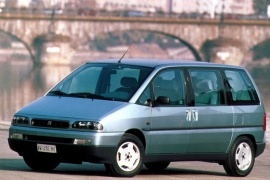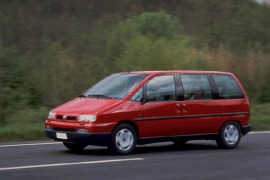FIAT Ulysse Models/Series Timeline, Specifications & Photos
First production year: 1994
Engines: Diesel, Gasoline
Body style: Van
Fiat introduced the second generation of the Ulysse in 2002 as part of an agreement with the PSA Group (Peugeot-Citroen).
The minivan era was still trendy in 2002 when the Italian carmaker introduced the Ulysse II. It was a minivan that could carry seven passengers in comfort and safety. Since it was a joint project, both sides agreed to build the MPV with a few differences, other than just a specific front fascia. There were different steering wheels as well.
Fiat had the honor to show the car earlier than its French partners. Strangely, it featured a less-inspired front fascia with rectangular headlights and a trapezoidal grille. The big, raked windshield followed the hood at about the same angle. On its sides, it showed regular front doors and sliding doors for the rear passengers. In the back, the two companies agreed to install a big and broad liftgate.
Inside, the carmaker installed seven individual seats on three rows. Apart from the front ones, the other could slide or be completely removed if needed to increase the cargo area. The designers chose to install the instrument cluster in the middle of the dashboard so that anyone on-board could read the speedometer.
Under the hood, the Italian carmaker installed a choice of five engines: two with gasoline and three turbodiesels. All of them were produced by PSA and mated to a 5-speed manual or a 5-speed automatic. Two years after the launch, the U.K. customers were offered a 6-speed manual on the options list.
After four years on the market, Fiat had to update the Ulysse minivan produced together with the French group PSA.
By 1999, it was already clear for the Italian carmaker that the minivan segment was dying and, apart from Renault, which marched with its Espace, the Ulysse and its siblings were doomed. But Fiat's beancounters considered that the MPV can still produce some money. Thus, the Eurovan project was continued.
The upgraded version sported a revised front fascia. It dropped the squared-looking headlights and replaced them with ones with softened edges. The grille also went through some changes and added a few slats that supported the small Fiat badge placed in the middle. It was so tiny that some wondered if the carmaker was ashamed to put it on this minivan. To make it look more attractive, the exterior cladding and the door handles were body-colored, like many premium vehicles.
Inside, the dashboard looked similar to the one that it replaced, although there were some materials improved and better-designed dials inside the instrument cluster. Like its predecessor, the Ulysse provided room for up to seven people with a pair of regular doors for the front passengers and two sliding doors for the rest. At the back, the wide and tall tailgate allowed comfortable access to the trunk.
Under the hood, Fiat worked together with its partners and improved the engines such as the 2.0-liter turbodiesel, which was available starting with January 2001.
The Ulysee was appreciated for the versatility, great handling and modularity offered. The vehicle greatly combined the typical functionality of a wagon comfort specific to a saloon.
The Ulysee had an elegant style, with the two curved surfaces blending with the large windows. The front was harmonious, with the large wrap around windscreen, together with the radiator grille and the headlamps.
Featuring 2 sliding side doors that were perfectly hidden within the body work, the Ulysee offered easy access to the back seats.
At the back, the car had a large rear door with a reduced grown clearance to allow easy loading of heavier items.
The Ulysee was 445 cm in length, 171 cm in height and 183 cm in width.
The exceptional handling came with standard power steering.
A choice of two engines was available, both 4-cylinders mated with a 5-speed gearbox.
The braking system consisted of ventilated discs at the front and drums for the rear.
The ABS system was available on the whole range and was standard for the upper trims.
The high driving position offered great visibility for the driver.
The interior was well thought, with the center console having the shape of an island that included the heating and the ventilation controls, as well as the gearbox lever. The gear knob’s position required minimum movement of the arm for gear shifting.


